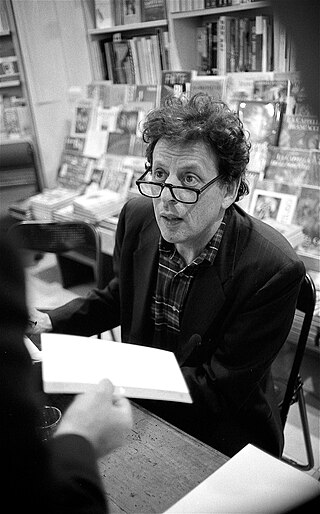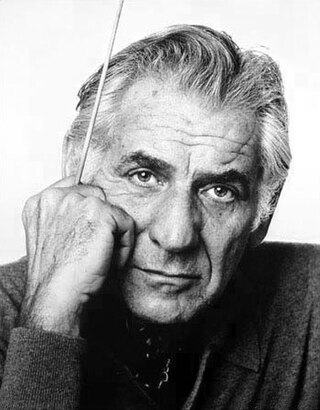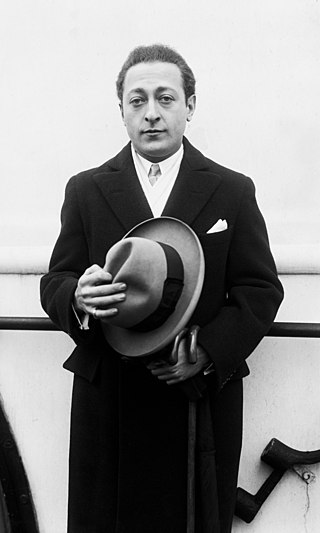Related Research Articles

Philip Glass is an American composer and pianist. He is widely regarded as one of the most influential composers of the late 20th century. Glass's work has been associated with minimalism, being built up from repetitive phrases and shifting layers. Glass describes himself as a composer of "music with repetitive structures", which he has helped to evolve stylistically.

Leonard Bernstein was an American conductor, composer, pianist, music educator, author, and humanitarian. Considered to be one of the most important conductors of his time, he was the first American-born conductor to receive international acclaim. Bernstein was "one of the most prodigiously talented and successful musicians in American history" according to music critic Donal Henahan. Bernstein's honors and accolades include seven Emmy Awards, two Tony Awards, and 16 Grammy Awards as well as an Academy Award nomination. He received the Kennedy Center Honor in 1981.

The New York Philharmonic, officially the Philharmonic-Symphony Society of New York, Inc., globally known as New York Philharmonic Orchestra (NYPO) or New York Philharmonic-Symphony Orchestra, is a symphony orchestra based in New York City. It is one of the leading American orchestras popularly called the "Big Five". The Philharmonic's home is David Geffen Hall, at New York's Lincoln Center for the Performing Arts.

Sir William Turner Walton was an English composer. During a sixty-year career, he wrote music in several classical genres and styles, from film scores to opera. His best-known works include Façade, the cantata Belshazzar's Feast, the Viola Concerto, the First Symphony, and the British coronation marches Crown Imperial and Orb and Sceptre.

Sir John Barbirolli was a British conductor and cellist. He is remembered above all as conductor of the Hallé Orchestra in Manchester, which he helped save from dissolution in 1943 and conducted for the rest of his life. Earlier in his career he was Arturo Toscanini's successor as music director of the New York Philharmonic, serving from 1936 to 1943. He was also chief conductor of the Houston Symphony from 1961 to 1967, and was a guest conductor of many other orchestras, including the BBC Symphony Orchestra, London Symphony Orchestra, the Philharmonia, the Berlin Philharmonic and the Vienna Philharmonic, with all of which he made recordings.
Philip Smith is an American classical trumpet player. He is former Principal Trumpet with the New York Philharmonic and played with the orchestra from 1978 to 2014. Smith, born in the United Kingdom, is from a Salvation Army background. He assumed the co-principal position in the New York Philharmonic in June 1978 and the principal position in 1988. He also is a supporter of brass bands, performing with various groups of distinction.

The Violin Concerto by William Walton was written in 1938–39 and dedicated to Jascha Heifetz, who commissioned the work and performed it at its premiere on 7 December 1939 with the Cleveland Orchestra conducted by Artur Rodziński. The British premiere, delayed by the Second World War, was given on 1 November 1941, with Henry Holst as soloist and the composer conducting. Walton later reorchestrated the concerto; the revised version was premiered in 1944. The work has been frequently recorded and has established itself as one of the composer's most durable compositions.

Andre Kostelanetz was a Russian-born American popular orchestral music conductor and arranger who was one of the major exponents of popular orchestra music.
Ralph Vaughan Williams dedicated his Symphony No. 4 in F minor to Arnold Bax.

Josef Alois Krips was an Austrian conductor and violinist.
The Symphony No. 2 by William Walton was written between 1957 and 1960, and premiered in September 1960. It received a mixed reception at first: some critics thought Walton's music old-fashioned. Subsequently it has been re-evaluated and praised. The work was first performed by the Royal Liverpool Philharmonic Orchestra, conducted by John Pritchard and was first recorded by the Cleveland Orchestra, conducted by George Szell. It has subsequently been recorded by conductors from Britain, the US and elsewhere.

Glenn Dicterow is an American violinist and former concertmaster of the New York Philharmonic Orchestra. He is on the faculty of the University of Southern California's Thornton School of Music where he holds the Jascha Heifetz Chair in violin as well as serving as a faculty artist at the Music Academy of the West.
The Symphony No. 1 in B♭ minor is one of two symphonies by the English composer William Walton. The composer had difficulty in completing the work, and its first public performance was given without the finale, in 1934. The complete four-movement work was premiered the following year.
Spitfire Prelude and Fugue is an orchestral composition by William Walton, arranged and extracted in 1942 from music he had written for the motion picture The First of the Few earlier that year.
Johannesburg Festival Overture is a composition for orchestra by the English composer William Walton, composed for the 70th anniversary of Johannesburg in 1956.

Variations on "America" is a composition for organ by the American composer Charles Ives.
Improvisations on an Impromptu of Benjamin Britten is an orchestral piece by William Walton. It was first performed by the San Francisco Symphony Orchestra, conducted by Josef Krips, on 14 January 1970. Its European premiere was at Benjamin Britten's Aldeburgh Festival in June of that year. The work has subsequently been recorded for commercial release.

Scapino is a short work for large orchestra by William Walton, described by the composer as a "comedy overture". It was commissioned by the Chicago Symphony Orchestra and was first performed in 1941. A revised version was premiered in 1950.
William Walton's Variations on a Theme by Hindemith is an orchestral piece in eleven continuous sections, first performed in 1963. It is a tribute to Walton's friend and fellow composer Paul Hindemith.
William Walton's Sinfonia Concertante is a three-movement piece for piano and orchestra, first performed in 1928. The composer revised it extensively in 1943. It is an early work, in the anti-romantic style favoured by Walton before the 1930s. There have been several recordings of the piece, featuring both the original and the revised versions.
References
- 1 2 Liner notes to the premiere recording, mfp classics, CFP 4074
- ↑ William Walton.net/works Archived October 4, 2008, at the Wayback Machine